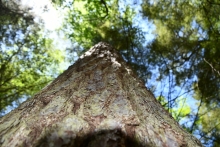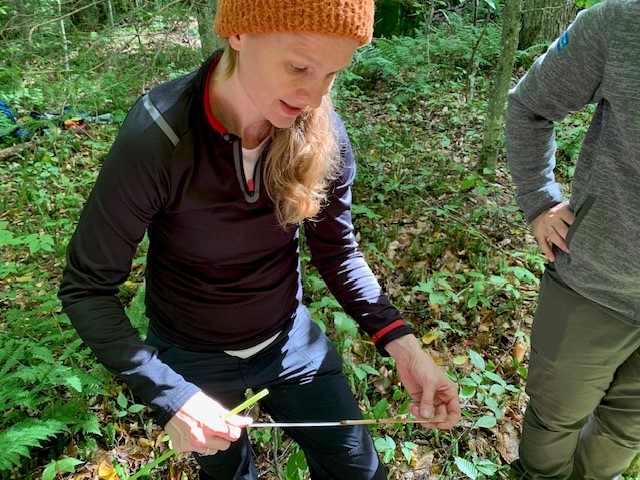You are here
Old-Growth Forests: Elders Under Threat

By Emily Johnson
For over a century, Harvard Forest researchers have been studying old-growth forests to better understand our past and prepare for our future. And for millennia, the People of the Dawnland – where the sun first touches the North American continent – have been in relation with these respected elders in ways far beyond measure. In more ways than we can imagine, our old-growth forests are in peril, and Harvard Forest researchers are concerned.
Walking throughout old-growth forests of the eastern seaboard, Harvard Forest researchers Dave Orwig, Neil Pederson, and Laura Smith have been following in the footsteps of Native Americans to uncover rich stories about forest change. Lynda Mapes, a Charles Bullard Research Fellow at Harvard Forest, has paid poetic homage to this research in a recent Atmos article: “What We Lose When We Lose Old-growth Forests.”

Last summer, Lynda joined the research team as they extracted tree cores, or tiny cross sections of annual growth rings. “With each turn of the borer, Smith, a research assistant at the Harvard Forest, quested through the tree’s present to its deep-time past. Finally at the tree’s heart, she paused and gently slid the tray out of the borer. Cradled in it was the core: a slender, biscuit-colored wand of time and a panoramic window into the past. I leaned in close and saw the core was still moist with life,” Mapes writes. “Smith paused and held the core in her palms, respecting the moment this tree’s story was first revealed.”
Back at the Tree Ring Lab, the research team uses a microscope to measure years of growth across groves of trees. “Year by year, every tree writes its autobiography, and the elders in any grove record wisdom earned over many centuries. How they got along and managed with their neighbors, the changes in their community, the days of harmony, strife, and struggle, and seasons of feast and famine.”
But with the introduction of nonnative insects, seasons of famine have taken a different form. Dave Orwig, Senior Ecologist and co-lead researcher on the project, recently wrote about his experience in the Boston Globe: “Over and over, we saw landscapes ravaged by insects and disease. Upon visiting more than 20 locations across four Eastern states, it became apparent that these forests were being irrevocably altered in a very short period of time. Most forests we studied had lost at least one dominant tree species,” Orwig writes.
And while our forests have generally remained resilient to introduced pests and disease for centuries, “now more than 450 exotic pests and diseases are present in our forests because of burgeoning global trade,” says Orwig. Nonnative organisms affecting our forests often arrive by hitching a ride in cargo containers within wood packing materials or within the soil and branches of potted plants.
Nonnative pests and pathogens threaten countless elements of our natural landscape, including carbon storage. In a 2018 paper, Orwig and a team of researchers found that the largest 1% of trees accounted for roughly 50% of the aboveground biomass. “That points to just how important big, old trees are as carbon sinks blunting climate change,” writes Mapes.
 Other forest pests – such as the emerald ash borer – threaten traditional lifeways of tribes in the region. “For the Wabanaki, the loss of the ash tree is a deep blow to their culture,” explains Mapes, who discussed the issue with Passamaquoddy basket maker Gabriel Frey, “The tree is uniquely suited to their basket making because of where and how it grows and how it can be worked. The Wabanaki call brown ash the basket tree. It also is at the heart of their creation story.”
Other forest pests – such as the emerald ash borer – threaten traditional lifeways of tribes in the region. “For the Wabanaki, the loss of the ash tree is a deep blow to their culture,” explains Mapes, who discussed the issue with Passamaquoddy basket maker Gabriel Frey, “The tree is uniquely suited to their basket making because of where and how it grows and how it can be worked. The Wabanaki call brown ash the basket tree. It also is at the heart of their creation story.”
With the future of our old forests uncertain, being considerate of our decisions can have a profound effect. “Put out the welcome mat for native pollinators, birds, and other wildlife that are drawn to native plants and sourced from local nurseries. Save a tree. Buy local goods that didn’t have to cross multiple oceans to arrive, possibly carrying stowaway pests,” advises Orwig.
Reflecting on the future, Mapes refers to Frey’s perspective on the past. “The wisdom of his elders has always called for taking only what was needed, expressing gratitude to the tree, and preserving ash for the next generation so there would always be enough to carry on their culture.”
Emily Johnson is Harvard Forest's Stakeholder Engagement Coordinator. Photos by Lynda Mapes.

